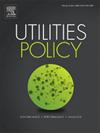Spatial analysis of energy communities and energy vulnerabilities in Spain
IF 4.4
3区 经济学
Q3 ENERGY & FUELS
引用次数: 0
Abstract
Energy communities are increasingly recognized for promoting citizen-led transitions toward a just energy system. This paper provides an empirical study examining the distribution of collective action initiatives (CAIs) within Spain's energy transition, focusing on their alignment with local energy generation configurations and energy vulnerability, reflected in socio-economic conditions at the municipal level. This study uses spatial and statistical analyses to assess CAI distribution with a minimal set of socio-economic indicators characterizing basic dimensions of energy vulnerability and its standardized index, as well as energy assets across Spanish municipalities. Results show modest correlations between CAIs and indicators such as income levels and measures of income distribution. However, no significant link is found with income inequality, as measured by the Gini index, when considering high and low-population municipalities separately. Spatial clustering analysis with Local Moran's I reveals a low yet significant association between mean household income and low-capacity PV installations in neighboring areas, suggesting localized economic factors may influence renewable adoption patterns. The study also investigates CAIs' limited impact on addressing gender disparities within the energy sector, finding weak correlations with gender-balanced participation. These findings underscore the strengths and limitations of CAIs in supporting community resilience while highlighting their current insufficiency in addressing broader socio-economic inequalities. Furthermore, this paper discusses the results within a framework for preliminary CAI mapping within energy vulnerability contexts, offering insights for analytically-guided municipalities selection for in-depth, mixed-method exploration of community-led energy initiatives.

西班牙能源社区和能源脆弱性的空间分析
能源社区在促进以公民为主导的向公正的能源体系过渡方面的作用日益得到认可。本文提供了一项实证研究,考察了西班牙能源转型中的集体行动倡议(CAIs)的分布,重点关注它们与当地能源生产配置和能源脆弱性的一致性,反映在市政一级的社会经济条件中。本研究采用空间和统计分析方法,利用表征能源脆弱性基本维度及其标准化指数以及西班牙各城市能源资产的最小社会经济指标集来评估CAI分布。结果显示,cai与收入水平和收入分配措施等指标之间存在适度相关性。然而,当分别考虑人口多和人口少的城市时,用基尼指数衡量的收入不平等并没有发现显著的联系。基于Local Moran’s I的空间聚类分析显示,邻近地区的平均家庭收入与低容量光伏装机之间存在较低但显著的关联,表明当地的经济因素可能影响可再生能源的采用模式。该研究还调查了CAIs在解决能源部门性别差异方面的有限影响,发现它与性别平衡参与之间的相关性很弱。这些发现强调了cai在支持社区恢复力方面的优势和局限性,同时强调了它们目前在解决更广泛的社会经济不平等方面的不足。此外,本文在能源脆弱性背景下的初步CAI制图框架内讨论了结果,为分析指导的市政当局选择提供了见解,以便对社区主导的能源倡议进行深入的混合方法探索。
本文章由计算机程序翻译,如有差异,请以英文原文为准。
求助全文
约1分钟内获得全文
求助全文
来源期刊

Utilities Policy
ENERGY & FUELS-ENVIRONMENTAL SCIENCES
CiteScore
6.80
自引率
10.00%
发文量
94
审稿时长
66 days
期刊介绍:
Utilities Policy is deliberately international, interdisciplinary, and intersectoral. Articles address utility trends and issues in both developed and developing economies. Authors and reviewers come from various disciplines, including economics, political science, sociology, law, finance, accounting, management, and engineering. Areas of focus include the utility and network industries providing essential electricity, natural gas, water and wastewater, solid waste, communications, broadband, postal, and public transportation services.
Utilities Policy invites submissions that apply various quantitative and qualitative methods. Contributions are welcome from both established and emerging scholars as well as accomplished practitioners. Interdisciplinary, comparative, and applied works are encouraged. Submissions to the journal should have a clear focus on governance, performance, and/or analysis of public utilities with an aim toward informing the policymaking process and providing recommendations as appropriate. Relevant topics and issues include but are not limited to industry structures and ownership, market design and dynamics, economic development, resource planning, system modeling, accounting and finance, infrastructure investment, supply and demand efficiency, strategic management and productivity, network operations and integration, supply chains, adaptation and flexibility, service-quality standards, benchmarking and metrics, benefit-cost analysis, behavior and incentives, pricing and demand response, economic and environmental regulation, regulatory performance and impact, restructuring and deregulation, and policy institutions.
 求助内容:
求助内容: 应助结果提醒方式:
应助结果提醒方式:


